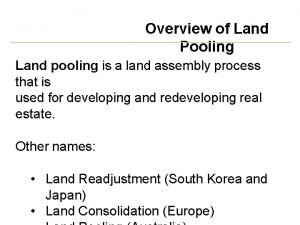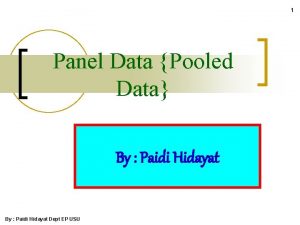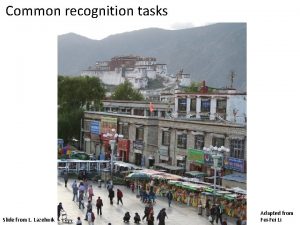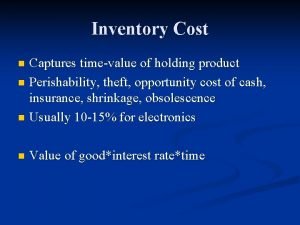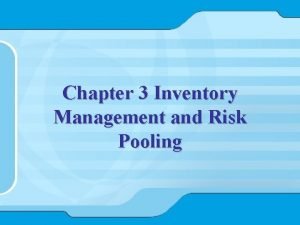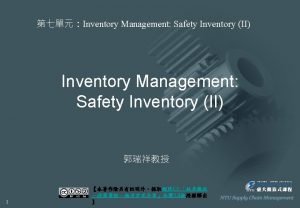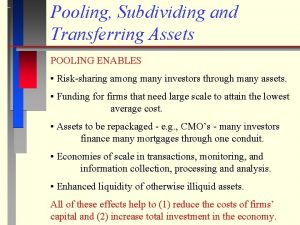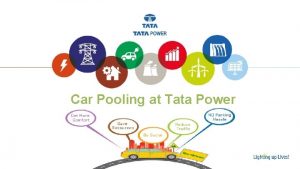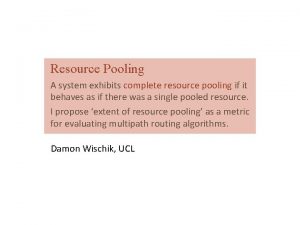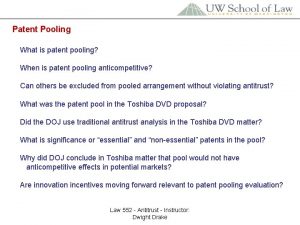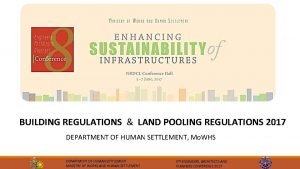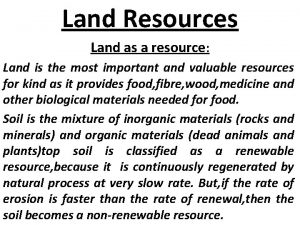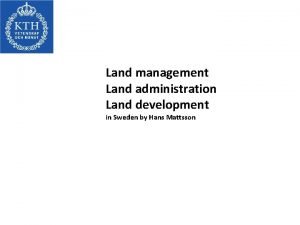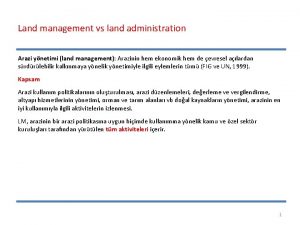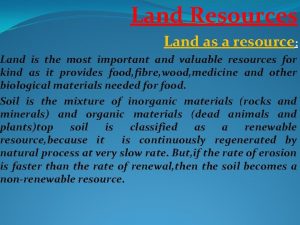Overview of Land Pooling Land pooling is a






















- Slides: 22

Overview of Land Pooling Land pooling is a land assembly process that is used for developing and redeveloping real estate. Other names: • Land Readjustment (South Korea and Japan) • Land Consolidation (Europe)

Befor e Overview of Land Pooling After (Source: Larsson,

Overview of Land Pooling Property owners work with local government or developers to reconfigure parcels for more optimal development and redevelopment in such a way that increases total land value. During an actual land pooling process, a number of private parcels is temporarily put into common ownership and later reallocated to a new highest and best use.

Land pooling was conceived in 1791 when George Washington (a former land speculator) and his associates used it to finance and build the new capital in Washington, DC Plan of the City of Overview of Land Pooling

Overview of Land Pooling Land pooling process for farmland in Germany: • Farmers temporarily put land titles in a common pool • Plan for more rational farmland boundaries was made • Titles were assigned back to farmers according to the plan

First major urban uses of land pooling: After the 1923 Great Kanto earthquake (Toyko), land pooling allowed the city to address a medieval street pattern and Examples of Land Pooling (Source: Yokohama Central Library)

Examples of Land Pooling First major urban uses of land pooling (continued) • Japan: Rebuilding of Nagoya, Osaka, Hiroshima and Yokohama after World War II. It was also used for land acquisition for ―Bullet Train‖ lines and stations. • South Korea: • 60% of the urban expansion of Seoul was accomplished through land pooling (1984 data). • 30% of the urban expansion of Daegu was accomplished through land pooling.

Overview of Land Pooling has also been used in Bhutan, France, Finland, Germany, India, Indonesia, Israel/Palestine, Nepal, the Netherlands, Sweden, Taiwan, Thailand, and in many other parts of the world. Historically it is has been used as a means to: • Capture land value increments to cover urban development costs • Adjust outmoded property boundaries

Overview of Land Pooling It has also been recognized as a tool to: • Facilitate land acquisition for urban development – speeding up the development process • Allow existing landowners to share the wealth generated from urban development • Promote housing development • Avoid gentrification (Home, 2002 and Hong, 2010)

Befor e How Does Land Pooling Work? After (Jabatan Perancangan Bandar Dan Desa - Senanjung,

How Does Land Pooling Work? (Source: Hong,

How Does Land Pooling Work? 1. Landowners volunteer to pool. Law provides: If a super-majority agree, minority must participate. 1. Agreement on development plan 2. Every fourth lot designated as ―cost-equivalent‖ lot 3. As lots are sold, money from ―cost-equivalent lots‖ pay off infrastructure costs. 4. If calculations are correct, land will be urbanized or redeveloped at no public cost. 5. Remaining urban lots are returned to original owners

Befor e How Does Land Pooling Work? After (Source: City Planning Bureau of Nagoya, Japan, 1982)

How Does Land Pooling Work? Sample Calculation of Net Gains Value of ten acres of undeveloped land Total cost of planning, subdividing, servicing Total value of urban lots created Net gain in value $1, 000 $600, 000 $3, 000 $2, 400, 000 Sale of 25% of urban lots would pay cost of infrastructure

Elements Essential to Successful Land Pooling • Premise of a strong land market • Land owners must believe final profits will be greater and land is worth the negotiating time • Reliable ownership records (cadastres) • Trained and credible assessors • Resolution of potential disputes through agreement or addressed by enabling legislation

Befor e After (Source: Kaohsiung Municipal Government,

Enabling Conditions for LP in Hampton Property Characteristics: 1. High differential increments in land values before and after land pooling project. 2. Government already owns 3. area in yellow 4. Major landowners in blue 5. agreed to sell land together. 6. Landownership (in blue, orange and red) is fairly concentrated. Two major property owners own area in red.

Enabling Conditions for LP in Hampton Landowner Characteristics: 1. Affected landowners have motivation to stay in the neighborhood. 2. Planning for redevelopment in the neighborhood has been participatory.

Enabling Conditions for LP in Hampton Technical, Legal, and Political Characteristics: 1. Technical skill is available for property assessments before and after land pooling. 2. There was a precedent that treated parts of the area as a unified unit for redevelopment. 1. The city is eager to revitalize the entire neighborhood.

Reflectio n Strengths 1. Developers with real estate development expertise can be involved in the early stage of redevelopment. 2. Land Pooling that requires the approval of the majority of landowners to execute land assembly is more democratic than is eminent domain. 3. Land pooling can avoid the heavy up-front capital requirement for property acquisitions by the local government. 4. Land pooling may allow urban redevelopment to

Land Pooling Development Financing Profits Developmen t Costs Property Cost Project Value

Reflectio n Challenges 1. There is no precedent of land pooling legislation. 2. Participation in planning and negotiation is time 3. consuming for property owners. 4. Public or private initiators of land pooling must have good negotiation skills. 5. All participating parties—land owners, the city, and developers—will have to share redevelopment risks. 6. Anticipated capital gains for participating landowners will not be realized until they sell their
 What is land pooling
What is land pooling High rocky land usually with steep sides
High rocky land usually with steep sides An area of land largely enclosed by higher land
An area of land largely enclosed by higher land Pooled cross section adalah
Pooled cross section adalah 08102005 colour
08102005 colour Risk pooling supply chain examples
Risk pooling supply chain examples Notional cash pooling versus zero balancing
Notional cash pooling versus zero balancing Cnn backpropagation
Cnn backpropagation Pooling stride
Pooling stride Adaptive average pooling
Adaptive average pooling Ttx railcar pooling experts
Ttx railcar pooling experts Inventory pooling
Inventory pooling Risk pooling supply chain
Risk pooling supply chain Max pooling layer
Max pooling layer Drug pooling
Drug pooling Risk pooling formula
Risk pooling formula Also known as electron pooling
Also known as electron pooling Drip trail pattern
Drip trail pattern Inventory pooling
Inventory pooling Metode pooling of interest
Metode pooling of interest Pooling stride
Pooling stride Inventory pooling examples
Inventory pooling examples Managerial levers
Managerial levers
